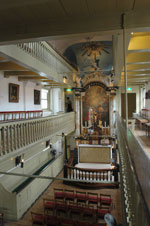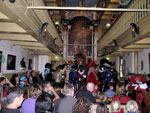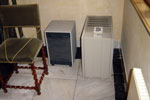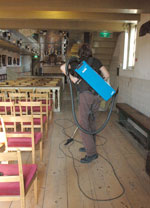Our Lord in the Attic: A Case Study
Guidelines
The Church in the attic
A tutorial has been created to help with the use of the web site and its features. This tutorial also features on the home page of the case study web site:
![]() Use of the web site (PPS, 6.1 MB)
Use of the web site (PPS, 6.1 MB)
Another tutorial is offered here to be used at the teacher's discretion. It shows how raw excel data can be converted into a graph:
![]() Creating graphs from excel files (PPS, 1.9 MB)
Creating graphs from excel files (PPS, 1.9 MB)
Practical guidelines
This online preventive conservation case study is designed to be used in a variety of ways, allowing for flexibility and the teacher's own creativity. Depending on the students' background and the time available, different aspects of the case can be dealt with at different levels. It is however assumed that the entry level for this case study requires a basic understanding of the museum 'environment' in terms of indoor climate (the concepts of relative/absolute humidity and material response) as well as the organization and operation of a museum.
The inherent nature of a web based case study makes it applicable to a variety of uses, from classroom teaching to self-study. It is however recommended to have small groups of students work on the case study and to reconvene and discuss each group's findings in the classroom. If students from different programs can be mixed for this exercise (for example students in object conservation with architectural conservation students), that would be incredibly valuable since the idea behind the development of this case study is that students get to know the 'real world' and become acquainted with stakeholders other experts that are likely to be involved in a situation like this.
It is suggested to let the student start on the case study homepage, where the student is addressed by the museum's director and asked to take on the role of consultant and to advice the museum on the issues of:
- Visitor management: how should the museum deal with the increasing visitor numbers; can - or should - a maximum visitor number or carrying capacity be established for the museum? What establishes the carrying capacity of a site (looking at visitation numbers, viewing time, visitor experience and satisfaction, emergency regulations, etc.);
- Wear and tear - should the museum reduce wear and tear? What kind of strategy should be put in place? An interesting discussion may be the pros and cons of a maintenance strategy (which indicates a level of repair) versus protection (which may conceal or reduce access to certain parts of the site).
- Indoor climate; should the museum do something about the indoor climate in terms of visitor comfort and/or collection/building preservation. What are the pros and cons of implementing any kind of climate control, from passive measures to the present localized humidity control to an HVAC system. Related to this could be a discussion on global climate change and its impact on this site.
In order to answer these questions, the student is given access to a a wealth of information. Several staff members introduce different aspects of the museum, which are collected in the main chapters represented in the navigation bar: Museum, Building and Collection. The other chapters of the web site provide information on the Climate and Visitation. Under Resources, the student can find valuable background information about the historic context of the site as well as recommended literature, a glossary and links to relevant web sites.
The information made available is in a variety of formats, just as it would be in the real world. Indeed, not all information is relevant, complete or even correct. Some information is presented in the form of raw data, as is the case with the climate data. Thus students can learn how to process and analyze data. It is up to the student to select the information he/she thinks is relevant to address the question(s) he/she is asked. The student will soon realize that he/she will need the expertise of other disciplines to interpret the available information and this may well be the most important learning curve from this case study.
Although this case study is about a historic house museum in The Netherlands, its concerns and issues can be easily transferred to other locations around the world.
Statue of St. Paul in the Church
Traditional Dutch festival of 'Sinterklaas' in the Church
Local (de)humidifiers in the Sael
Cleaning in the Church
Additional questions and discussion topics
Apart form the issues raised by the director on the homepage, several others questions can be posed to the students. These are described below, organized by topic. Please refer to Resources for additional information.
Collection (moveable collection and the building)
Is the collection at risk in the current situation? Dealing with subjects such as:
- Collection susceptibility to the 'nine agents of deterioration' (as defined in CCI's 'Preservation Framework for Museum Collections');
- Condition documentation and monitoring;
- What agents of deterioration caused the damage observed in the collection and when did it happen?
- The concept of proofed conditions - is it likely that any climate induced damage would get worse if the current conditions prevail? If the current climate related damage in objects were to be treated, how does one prevent the same damage from happening again?
- What are the options for mitigating the climate risks to the moveable collection and what are their pros and cons? Passive building measures, showcases, localized climate control by moveable units (such as (de)humidifiers and cooling units) and HVAC systems. Topic for discussion is the location of the current localized humidity control units (often next to radiator, objects. Dehumidifier next to humidifier).
- How do climate mitigation measures affect the building? E.g. unwanted condensation on building elements, loss or interference with authentic building elements.
- What are the options for mitigating the wear and tear of the building and what are their pros and cons? Visitor management through adjusting access, routing, visitor flows and dwelling time or the protection of original surfaces (use of slippers, floor covers).
Visitors
- Visitors' impact on the relative and absolute humidity, temperature and CO2 concentration in a room during normal visitation and during events;
- Visitors' comfort (indoor temperatures, CO2 levels - air exchange rates) and how this can be improved - from natural ventilation (e.g. opening windows), localized forced ventilation (electric fans and handing out small paper fans to visitors), localized cooling units to HVAC systems;
- Alternative climate management strategies - pros and cons of different opening hours, temporary closure during extreme conditions, reduction of events.
- How do climate mitigation measures affect the visitor's experience? E.g. if objects in the church were placed in showcases? Is a winter heated and summer cooled 17th century canal house an authentic experience?
- How do alternative climate measures affect the meaning of the site? E.g. if large group gatherings in the church for events were to be abolished, how would that affect the meaning of the site for local and regional people?
- How do mitigation measures to reduce the wear and tear of the building influence visitor experience and the visitors' safety (steep stairs)?
- Carrying capacity of the site - regulations (such as fire department), structural safety, dwelling time and routing.
Use of the building in its original function
Can you reflect on the current use of the church? Deals with subjects, such as:
- Risks to the building and the collection;
- 'Living history' and 'intangible heritage';
- Museum's mission and budget.
Sustainability
- The affect of global warming and climate change (more extremes in temperature and precipitation) on the site. Can we predict how often and for how long the indoor climate will reach extreme values and does that justify implementing a climate control system?
- Can the museum afford the installation, running and upkeep of a climate control system?
- Alternative climate management strategies - pros and cons of different opening hours, temporary closure during extreme conditions.
- Maintenance and repair versus protection (with possibly limited access);
- The role of this historic house museum's message about religious tolerance in the 21st century Dutch polarized cultural climate.
Other discussion topics
Communication
- Communication - how to communicate with other experts and how to reach a consensus.
- Communication - how to communicate with your client so that they can understand your reports. An example is the technical report from the engineering firm Prouw, which is an important report but is also extremely difficult to understand for a lay person.
- How to conduct an assessment - what questions to ask when gathering information. When first asked if the windows in the Sael were ever used for ventilation, the facilities manager strongly said 'no'. We discussed this while standing in the Sael at the time. It was at that exact moment that somebody from the internal services department came in and opened the windows to close the shutters, demonstrating that these windows have to be opened every day to close and open the shutters on the outside. This illustrates that you have to be careful how you phrase a question - using windows for ventilation obviously has a different meaning to opening the windows for a security action.
Security and safety of the museum. Dealing with issues such as:
- Unaccompanied 'free' tour versus guided tours.
- Use of fixed room stewards.
- Location of fire extinguishers.
A tutorial is offered here to be used at the teacher's discretion. It shows how raw excel data can be converted into a graph:
![]() Creating graphs from excel files (PPS, 1.9 MB)
Creating graphs from excel files (PPS, 1.9 MB)
Three examples of an assignment
In addition to the questions and discussion topics, we offer three examples of an assignment.
Subject: Climate induced damage to collections
In this assignment attention can be given to the way in which wooden sculptures respond to fluctuating climatic conditions. The Polish Academy of Sciences part of the EU project ‘Friendly Heating’, analyzed the behavior of a wooden sculpture in a small Italian church, showing the difference in response of a large wooden head versus a small finger. From these findings the future thresholds for the indoor climate could be deduced using the method presented in the ICOM-CC paper given below.
Literature
Bratasz, Ł., Jakieła, S., Kozłowski, R. (2005) Allowable thresholds in dynamic changes of microclimate for wooden cultural objects: monitoring in situ and modelling, preprints of the Triennial ICOM-CC meeting (14th), The Hague, 12-16 September 2005, p. 582-589. http://heritage.xtd.pl/aboutus/ICOM2005.pdf
Bratasz, Ł., Kozłowski, R. (2005) Laser sensors for continuous in-situ monitoring of the dimensional response of wooden objects, Studies in conservation , 50, No. 4, p. 307-315. http://heritage.xtd.pl/aboutus/LaserSensors2005.pdf
Bratasz, Ł., Kozłowski, R., Camuffo, D., Pagan, E. (2007) Impact of indoor heating on painted wood: monitoring the altarpiece in the church of Santa Maria Maddalena in Rocca Pietore, Italy. Studies in Conservation, 52, No. 3, p. 199-210. http://heritage.xtd.pl/aboutus/LB_Camuffo.pdf
Bratasz, Ł., Camuffo, D., Kozłowski, R. (2007) Target microclimate for preservation derived from past indoor conditions. Contributions to the Copenhagen conference 19 - 23 November 2007 Museum Microclimates. Padfield, Tim and Borchersen, Karen (editors). p. 129-134. http://www.nationalmuseet.dk/graphics/konferencer_mm/microclimates/pdf/bratasz.pdf
Jakieła, S., Bratasz, Ł., Kozłowski, R. (2008) Numerical modelling of moisture movement and related stress field in lime wood subjected to changing climate conditions. Wood Science and Technology, 42, p. 21-37. http://heritage.xtd.pl/aboutus/PublikacjaSJ1.pdf
Assignment
The students can use the information from the web site to analyze the past and present climate in the church of Our Lord in the Attic and assess the damage to the collection, especially the statues of the Saints Peter and Paul and the small Putti in church.
Using the response times of the wooden objects which objects should be considered most susceptible in the current indoor climate? The Putti is more susceptible indicated by the flaking paint .
When is the current damage most likely formed? Our analysis of the historic indoor climate made us deduct that the majority of the climate induced damage was formed in the period when central heating was first installed and there was no humidification (1953-1990).
What do you think are the most important climate issues in the Church? The risks to the movable collection are considered to be relatively small. However, humidification in winter increases the risk of condensation on building elements, causing rotting beam heads and window frames.
| Action | Time needed |
Plenary introduction to the subject by teacher |
30 minutes |
Researching the web site for signs of climate induced damage |
2 hours |
Climate assessment using data from the web site |
3 hour |
Plenary discussion |
30 minutes |
Total time |
6 hours |
Subject: Maintenance or protection?
Both maintenance and protection are common practices in historic museums. In this building the floors and stairs show signs of wear and tear. If nothing is done, then the wooden floors will become too thin and damaged to ensure visitor safety. In the past worn out planks were turned up side down, broken keys were replaced and thin floor boards were replaced by planks from another room in the building that were less worn or sometimes by planks from other old canal houses in Amsterdam. In the past decades there has been no policy in place to deal with this issue and as a result only vital repairs have been carried out. At this point in time several floor boards are in a bad condition. However the original wooden floors and stairs are of enormous value (experience, authenticity). How can the museum address this dilemma?
Assignment
Starting with a group discussion on the general topic of maintenance versus protection, students could research the web site for signs of damage to the floors and stairs and relate this information to current and future visitor numbers. From this information the future damage rate could be assessed. Is it possible to predict when an unacceptable risk is to be expected? Which mitigation strategy would be advised? Are there protective measures that will reduce the rate of wear and tear?
| Action | Time needed |
Plenary discussion |
30 minutes |
Researching the web site for signs of wear and tear |
2 hours |
Assessment of visitation numbers using data from the web site |
2 hour |
Research mitigation strategies for other historic house museums |
1 hour |
Plenary discussion |
30 minutes |
Total time |
6 hours |
Subject: Value Assessment
Decision making in a museum is based on a value assessment. It is often the case that not all collection units are of equal value and that decisions are made using different values at the same time. The case study does not give any direct information about a value assessment, but it does give enough information to perform this yourself. The assignment could start with thinking about the most relevant values for any collection in any museum:
- Why do we collect?
- How does a specific collection unit add to the overall value of the museum?
- Can we draw a value pie that shows the value distribution of the main collection units in the collection? In this case moveable collection versus building.
Literature
Russell, R.; Winkworth, K., Significance: a guide to assessing the significance of cultural heritage objects and collections, Heritage Collections Council. Canberra, Australia, Canberra: Heritage Collections Council (2001). http://sector.amol.org.au/publications_archive/museum_management/significance
Waller, R.R., Cultural property risk analysis model: development and application to preventive conservation at the Canadian Museum of Nature, Gothenburg Studies in Conservation, 13, Acta Universitatis Gothoburgensis, Gothenburg, Sweden (2003).
Assignment
Based on the information provided on the history of the museum and church, the current use of building and collection and the mission statement, students could write a statement of significance for the whole collection (building and moveable collection) or parts of it, e.g. focus on a specific collection unit. As a result of a group exercise the value distribution can be calculated using an excel data sheet or the analytical hierarchy program provided by CCI. This kind of exercise can be extremely useful. Most often it is experienced as provocative.
| Action | Time needed |
Plenary brainstorm: Which values are relevant? |
30 minutes |
Researching the web site |
3.5 hours |
Writing Statement of Significance |
1 hour |
Value distribution exercise |
30 minutes |
Plenary discussion |
30 minutes |
Total time |
6 hours |
Add Main Content here.




